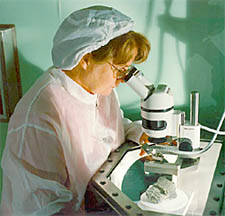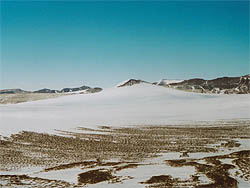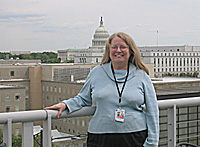Student Features
Chip off the Old Rock
04.28.05
| Who Are NASA's Space Science Explorers? Who are NASA's Space Science Explorers? The scientist studying black holes in distant galaxies. And the engineer working on robotic machines bound for space. But also the teacher explaining the mysteries of the cosmos to his or her students. And the student wondering if there is life anywhere besides Earth. All of these people are Space Science Explorers. They are all linked by their quest to explore our solar system and universe. This monthly series will introduce you to NASA Space Science Explorers, young and old, with many backgrounds and interests. Nominate a Space Science Explorer! Tell us about the Space Science Explorers you know. We're looking for students, teachers, scientists and others who have a connection to NASA, whether they work for the agency or are involved in a NASA-supported mission or program. Send your nominations to Dan Stillman: dan_stillman@strategies.org. |
 |
Lindstrom worked 14 years for NASA as a "meteorite curator." She watched closely over a large group of meteorites. Meteorites are chunks of rock that have fallen to Earth from outer space. These rocks hold secrets to the origins of our solar system. Most are 4.5 billion years old!
Image to left: Marilyn Lindstrom examines a meteorite sample. Her suit is meant to keep dirt away from the sample. Credit: NASA
It was Lindstrom's job to take good care of these mostly stony masses. She made sure they were handled carefully and kept clean. And she helped prepare them for research. The rocks had to be split into smaller chips that could be sent out to scientists. She did such a good job that an asteroid and mountain were named after her.
Why an asteroid? Because most meteorites come from asteroids. Asteroids are large rocks that orbit the Sun. Sometimes these rocks collide and smaller chunks break off. The chunks that fall to Earth are called meteorites.
And what about the mountain? It's called "Lindstrom Ridge." It's in Antarctica, which is where the meteorites she took care of came from. Lindstrom was honored to have an asteroid named after her. She was even more excited about the mountain.
"There are quite a few space scientists that have asteroids named after them," she said. "But only a handful that have Antarctic real estate as well."
 |
Scientists can learn a lot from meteorites. The minerals they contain provide clues to how the solar system was formed. Meteorites found in Antarctica are of special interest. The icy climate there helps to preserve the rocks more so than those found in warmer areas of Earth.
Not all meteorites come from asteroids. A select few appear to have come from the Moon and Mars. These are important samples. It's been a long time -- more than 30 years -- since astronauts went to the Moon. And humans have never set foot on Mars. NASA is planning to send astronauts to both the Moon and Mars soon. Until then, lunar and Martian meteorites can teach us a lot about these distant places.
Lindstrom enjoys working with meteorites. She likes that her work involves both geology and chemistry. Geology is the study of rocks and other solid matter. And chemistry is the study of elements, like iron and nickel. Meteorites sometimes contain these and other elements.
 |
There was a time, when Lindstrom was in school, that she wasn't sure what she wanted to do. The combination of geology and chemistry is what finally hooked her.
"I was interested in everything. I couldn't make up my mind whether I was going to major in math or science or foreign languages," she said. "It just all clicked... when I put chemistry and geology together."
Lindstrom hopes that more young people will find the joy and enthusiasm for science that she discovered. Part of her current job at NASA is to teach people about the solar system. She wants kids to know that science is fun, and that anyone can do it. Plus, there's always the chance that an object in space or piece of land here on Earth could be named after you.
Even a company can't buy that kind of fame.
Related Resources
KSNN™: What is a meteorite?
+ View site
Space Rocks
+ View site